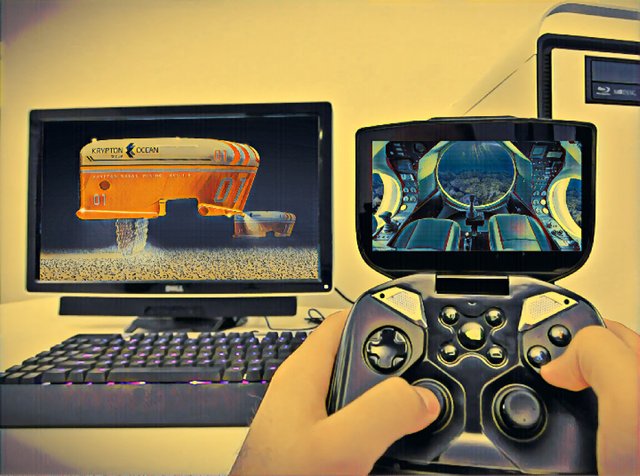
We are living in the age of hybrid solutions. Hybrid wars, hybrid vehicles, hybrid biological objects all reflect the trend of the synergy we are facing in these days of a growing complexity of the contemporary socio-economic relationships.
Just look at such an ambivalent topic as the so-called “Cobalt Crunch”. The skyrocketing interest in electric vehicles throughout the world resulted in the enormous demand for batteries where rare metals such as cobalt, nickel, and lithium play a crucial role. Now we can see how Elon Musk is trying to provide a sustainable production of his Tesla Model 3. He is looking for cobalt suppliers all over the world. Another EV manufacturer Volkswagen Group spent billions of dollars on the contracts able to provide the car giant with a stable supply of the battery metals in the nearest perspective.
The situation looks very unusual in the present days of a post-industrial economy: the demand for physical commodities in the form of rare metals exceeds supply as it is an old-school classic capitalism. Moreover, we face the well-worn chicken & egg dilemma when it is necessary to determine the sequence of actions in the new electric-driven economy: should power generation go prior to power storage or vice versa? And even more precisely: should the entire post-oil economy depend on rare minerals’ mining?
In addition, the solution for the current battery crisis is exacerbated by two interlinked circumstances. On the one hand, the four-fold growth of the cobalt price (it is expected to be 10-fold by 2025!) is grist to the mill of stock traders who seize the moment for making money from thin air — nobody’s canceled stock-market speculation yet.
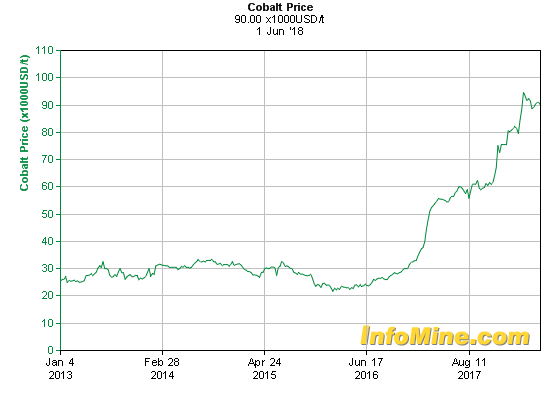
And every mining corporation able to declare some cobalt-supply capabilities can easily pump its capitalization in the wake of the cobalt shortage.
On the other hand, the continental deposits of rare metals are limited — the combined supply of the prospective Australian lithium along with rich Congolese cobalt can hardly satisfy even one fifth of the battery metal demand appearing in the light of 130 million EVs we expect to see on our roads by 2030.
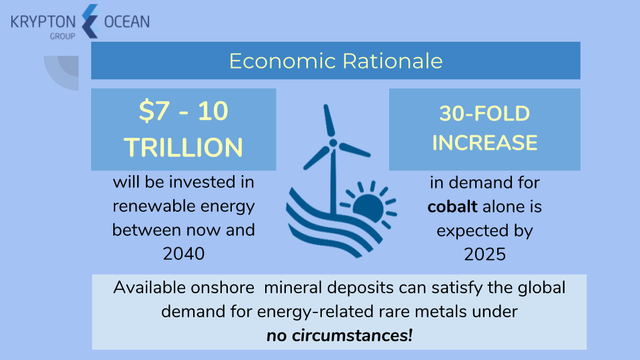
With regard to all above the idea that a special hybrid solution aimed at beating the present “Cobalt Crunch” doesn’t seem too weird.
Let’s try to figure out some possible objectives of a synergetic project capable of adding flexible viability to quite a closed environment of mining investment as well as to a progressive seabed mining technology aimed at saturating a global market with rare minerals.
The actual existence of a seabed mining sector can be an eye-opener for the majority of the global population. In fact, about 17 countries are involved in the international relations regarding the enormous mineral treasures available at the ocean bottom. Moreover, a special UN authority was established in order to regulate the seabed exploration & exploitation activity in the areas beyond the national exclusive economic zones. Millions of square kilometers of the ocean floor are covered with billions of tons of mineral sediments capable of providing the whole humanity with metals for hundreds of years.
.jpg)
However, only a handful of organizations is involved in the real seabed mining today. And just this circumstance is what we consider absolutely wrong. Millions and millions of people all over the world should be aware of what a huge mineral resource belongs to everybody on this planet. Moreover, the correctly created algorithm of cooperation can provide millions of people with a significant income from such a lucrative business as the seabed mining of rare metals.
Everything you will find below in this post reflects our original approach to the issue. The gamified software platform we are going to create can help those few companies and organizations that run actual seabed mining to send a call-to-action message to the world community regarding their noble mission.
We believe that our game is able to revolutionize the whole extractive industry when millions of common people have a means of interaction with the actually working seabed mining companies. Moreover, such a synergetic product as our game can help figure out the right methods and rules making seabed mining technologies eco-friendly.
Just through our game, the collaborative efforts of all involved parties can save the oceanic biodiversity when the renewable mineral deposits are kept always renewable under a proper mining process.
We are going to start our explanations with the technology we consider the most appropriate for our concept.
Probably no other technology in the post-industrial economy can be compared with DLT (or Blockchain) in terms of its applicability to various sectors. Virtual crypto assets offer the unprecedented security, transparency, and decentralization to everything related to financial transactions on the Internet.
The only and the biggest drawback of crypto assets is that they are purely virtual having no tangible background in the real world.
That’s why hundreds of crypto projects conducting ICOs have ended with nothing after all. The community of singular crypto investors gained a lot of experience over several past years to be more discriminating about numerous bubble-type projects still abundantly available in the blockchain environment.
Those few attempts to link cryptocurrencies with various real-sector commodities (such as Petro coin backed by Venezuelan oil deposits along with the authority of President Maduro) failed to gain momentum due to just a declarative and highly conventional nature of their links. The projects were lacking something credible between crypto and real assets, something capable of building a solid bridge between those who own real assets and those who mint crypto coins.
At first sight, our idea to objectify crypto with metals seems impossible at all. And it is always so when crypto dominates in such a system. Any ICO procedure won’t be of any help if the main objective comes to collecting a certain amount of money through crowdfunding only.
We believe that the issue should be addressed from a different angle. It is necessary to deprive crypto of its dominant position in the scheme of relationships between all entities within the project. A cryptocurrency (a token, or any other cryptographically empowered virtual asset) should play a technical role to be just a tool having a particular functionality.
In our case, a crypto asset should simplify the way through which common people get access to the rare metals’ market. It is crucial not to mix a subject of our concept with its object. The subject is a metal market, the object is a singular crypto investor accessing that market.
And between them, there should be a link in the form of a product, not in the form of just a virtual cryptocurrency!
Of course, the product can and should contain one or several crypto assets as internal instruments. But the product as a whole is to be able to act as a means of blurring the line between virtual crypto economy and a real sector. Needless to say that only software can meet the requirements of such a product.
However, the types of software differ. Without diving deeply into the details of software development let’s specify our hypothetical software product as a “computer-game-as-a-crypto-investment-interface-to-mineral-market”. It sounds too ridiculous and overcomplicated. Nevertheless, we hope that the following details will show both the non-trivial functionality and practical applicability of our hybrid approach.
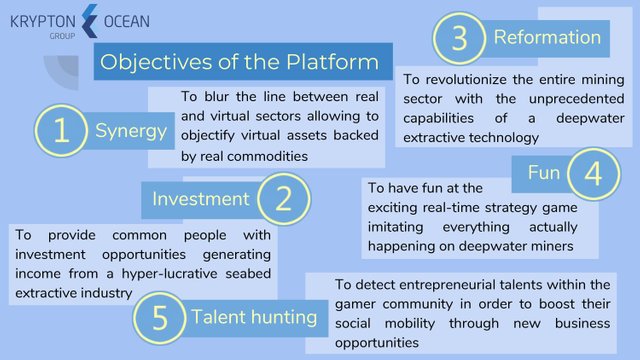
First of all, the software platform should be gamified. Why? Because a public recognition of such a boring topic as mineral mining is hardly possible without a gamification in the present digital era when every aspect of our day-to-day routine is saturated with various virtual experiences.
We are not going to change the subject-related vision specified in one of our previous posts:
“… Everything in the digital environment is gamified, take it or leave it. The king of the contemporary communication — social media look and work like a game. Every website behaves like a gameplay. Every communication channel beginning from email and up to mobile messengers makes us playing with taps and clicks on our gadgets. We are continuously playing while working, shopping, communicating, and having fun…”
So let’s turn the “mundane, trivial, real-sector, and maturely industrial” mineral mining into an exciting game! Let’s transform the extractive industry into a funky business.
It’s only a matter of creativity to represent everything actually happening in the deepwater mineral miners as a multi-level gameplay of a quest-like real-time strategy game. Besides, the deepwater adventures are remaining one of the popular topics for Hollywood blockbusters.
In general, the platform should have three interrelated layers: a gameplay, a crypto, and an investment interface.
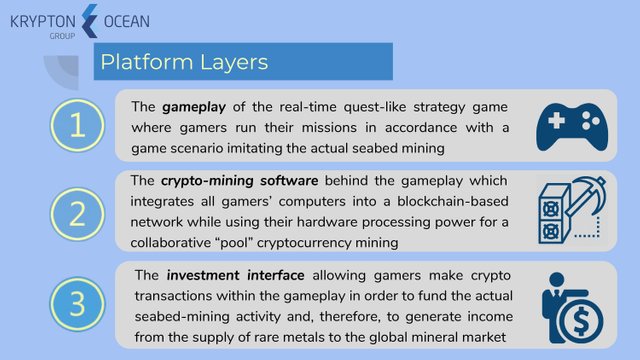
Let’s first speculate a little what the game layer might look like.
In order to add some contest excitement to the game, four competing mining companies will be available. Why four? Because each of them will mine one of four “fancy” metals — cobalt, copper, nickel, and manganese. Just those four metals are abundantly available inside the so-called polymetallic nodules constituting the mineral treasures of the Earth’s oceans. All four companies will mine the same nodules but the metals they extract from nodules will be different. The companies are the virtual employers for whom all gamers will “work”.
So, each newcomer can select one of four metals to mine and, therefore, one of four companies to work for. A special set of options will help gamers to select an employer. The options can include a Labor Contract, for example, where various terms and conditions relevant to the future game missions can be specified. Different companies would have different terms & conditions in their Contracts. They might concern a compulsory working period before a gamer could change an employer or, for example, a company’s commision charged from each lot of virtual metal mined by a gamer and so on.
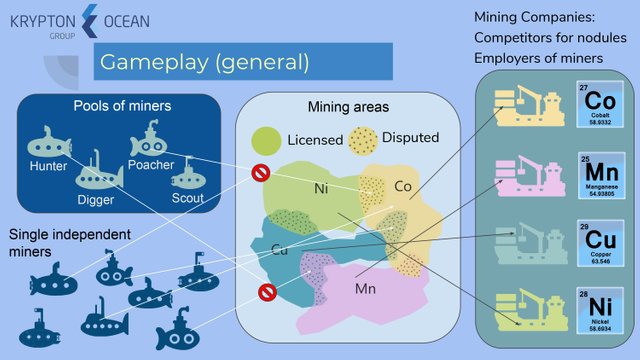
Each company will have a licensed piece of the seabed area where its employees (gamers) can mine nodules. The areas can overlap in some places where the disputed territories appear. It’s a chance for the so-called Poachers to grab some illegal nodules unless the so-called Hunters catch them to raise a penalty. Every gamer can play a specific role in the game. For example, you can be a Poacher if your deepwater vehicle is equipped with a more speedy engine allowing you to escape from the Hunters. Or you can be a Hunter if you have a more sensitive sonar allowing you to detect a Poacher earlier. The advanced equipment you can have on your vehicle is a matter of the available paid options. But more on that later.
In order to provide a multi-user socialization within the game, all miners working for one company will be able to meet in squads or in the Pools. The in-built self-governing opportunities will allow distributing roles within a pool. The Pool moderators will be electable. Even the Miner Benevolent Fund will be available. The “Pool mining” seems more efficient than a single miner’s mining unless a single miner’s vehicle is upgraded with all possible expensive options. Anyhow, a group work is to be more preferable especially for the newcomers.
For example, a newcomer having just basic options can find more nodules thanks to the Scouts who reveal the richer seabed areas in exchange for some payment. In general, there will be numerous types of in-game peer-to-peer transactions between gamers charged with micro fees in favor of the game owners, by the way.
In addition, there will be various opportunities to earn more metal or money within a Pool through an internal leasing, for example, when a wealthy gamer purchases some extra options (equipment) from a company to provide the poorer gamers with a leasing service.
Thus, the game starts for every new gamer when s/he pays a teeny fee for signing up. At that stage, the gamer will be provided with a basic model of the deepwater vehicles along with charts of the seabed area where mining for a particular employer is authorized.
The mining race implies a multi-level competition between miners of the same company as well as between companies. The objective of each gamer is to mine as many nodules as possible to exchange them afterward for virtual metals or for the internal cryptocoin which, in its turn, can be exchanged for real metals reserved for the gamers at one of the international metal exchanges.
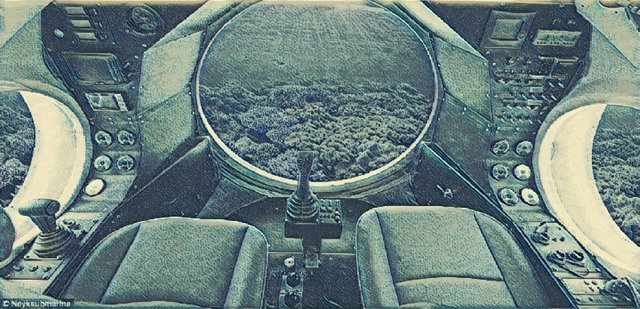
The in-built feature of communication and interactions between gamers within the gameplay will facilitate their missions when:
Hunters penalize captured Poachers;
Poachers redistribute illegally mined nodules among Diggers of the same Pool;
Scouts exchange valuable geological info for nodules from the other gamers;
Diggers offer their large bunkers to share with smaller miners who do not want to spend their time for floating up to ship nodules to the Company’s vessels;
Wealthy gamers offer the other ones some extra options in a lease;
Pool Moderators conduct an in-pool casting to arrange the best proportion of the internal roles the pool gamers can play;
Single independent players offer various services they can provide to play particular roles the pools are currently lacking etc.
Every single player will be able to upgrade his/her vehicle with various options available for extra payment. Hence, a more powerful propulsion, for example, will be offered to those who want to be the Poachers — they should be able to escape from the Hunters tanks to the higher achievable speed. A bigger nodule bunker will allow a Digger to work longer in the underwater position and therefore to collect more nodules per a single dive. The one who wants to be a Hunter can buy a more sensitive sonar to detect Poachers earlier that they can escape etc.
Both the game script and a multi-user architecture of the software will represent gamers numerous opportunities for leadership. It means that each gamer can improve his/her internal status when the actions s/he undertakes in the process result in better commercial outcomes. In other words, the initial conditions will be the same for everyone, but such personal capabilities as dedication, business intuition, and the ability to compromise along with the amount of money every gamer invests in the options will determine how successful one or another gamer will be in the game.
Such kind of natural selection, by the way, will matter far beyond the game environment since one of the objectives of our platform implies a talent hunting: the most successful gamers will be invited to take the actual management positions in the board of directors of Krypton Ocean Group. And this is just the synergetic feature that helps to bridge the gap between a virtual game environment and the real-sector industry distinguishing our gamified platform from the rest games at the same time.
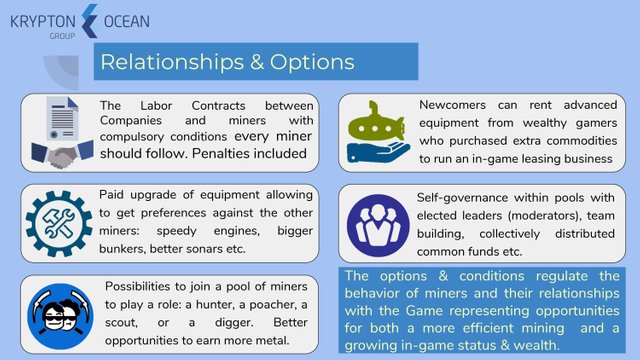
However, the gameplay along with all possible opportunities and features should be designed in cooperation with a professional game development company which is able to grasp the magnificent potential of our concept. Just the game professionals can add the sufficient extent of excitement a really addictive computer game represents. Nevertheless, the future gamers of our “Seabed Mining Race” will never miss the pragmatic business objectives staying behind the fun they have while playing because our “game-as-a-business” concept implies strengthening their actual wealth.
And now we come to the second layer of our platform making the whole project applicable to an actual commerce.
The crypto layer is a blockchain-based part of our software serving as a specific buffer zone between a virtual environment of the game and the real-world mineral market.
There will be two virtual crypto assets in the game: an internal cryptocurrency named KRYPTON (abbreviated to KPTN as it is accepted among crypto exchanges) and four virtual metals reflecting the actual cobalt, copper, nickel, and manganese from real life.
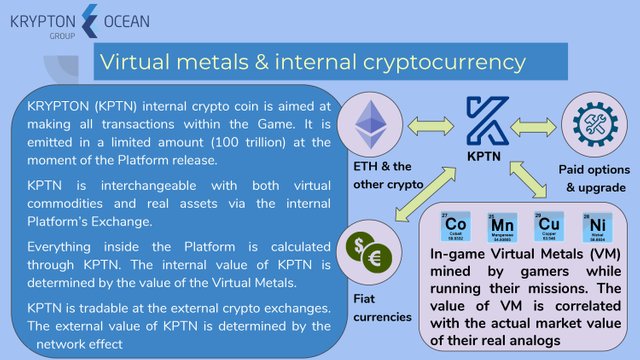
The gamers will mine virtual metals in the game while all in-game transactions will be conducted in KPTN. Why is it so? Why not use some actual fiat currency?
Whatever fiat currency is taken, it can hardly meet the agility inherent in the gamers’ community since neither state borders nor national legislations are available within the game. How to facilitate the whole range of the numerous peer-to-peer transactions between gamers in the game as well as between gamers and the actually working seabed mining companies at the same time? Only a virtual crypto asset can do it when a blockchain-based layer of the software platform acts as a membrane the main function of which is to provide a transition of a game content to a real-sector industry and vice versa.
A crypto coin used for internal transactions in the game will unify the commercial interactions playing the same role as a national currency plays inside a state monetary system. The only difference a crypto coin has in contrast to any national currency is that it can gain more value in the course of time while every fiat currency is always losing its value.
The main difference of our KPTN from the rest cryptocurrencies will be in its service function implying no domination in terms of goals the emitters of KPTN pursue. The emission of KPTN will never be an end in itself. That’s why a crowdfunding ICO procedure seems redundant in our case, by the way, since some different fundraising capabilities will be available on the platform.
Hence, the KPTN crypto coin will allow any gamer from any part of the world to access to all options in the game as well as to exchange KPTN for virtual and real metals through an internal platform exchange. Everything within our platform will be calculated through KPTN. And the process will be quite dynamic since every new gamer will add the so-called network effect to the platform that will, therefore, continuously increase the value of the whole project.
Another important function the crypto layer will provide is the self-sufficiency of the game as a software product. The thing is that each gamer will be able to sign up for the game in two different modes:
as a “gamer-as-a-gamer” and
as a “gamer-as-an-investor”.
The first mode implies an ordinary mode similar to signing up for a website. A “gamer-as-a-gamer” will be able to play the game having quite limited options in comparison with a “gamer-as-an-investor”. In addition, all internal charges and fees will be higher for such type of gamers while the exchange rate of KPTN will be less beneficial.
The second mode will imply using a part of a gamer’s hardware processing power in favor of the platform. It means that signing up “as-an-investor” a gamer will “invest” a part of his/her computing resource for the collaborative pool mining of some popular cryptocurrency (most probably ETH) when the platform is rewarded for new blocks mined in the blockchain.
Such a mode is mutually profitable for both the gamers and the platform. The “gamers-as-investors” will have numerous preferences such as lower charges and fees, significantly more beneficial KPTN exchange rate, a broader range of options etc.
The platform, on the other hand, will be able to maintain its infrastructure through incomes from crypto mining. Besides, the more processing power is involved in the ETH mining, the higher value KPTN can obtain and the greater profits both gamers and the platform owners can get as a result.
Just the collaborative crypto mining can make the game self-supporting within the virtual environment without any income coming from the real-sector business.
However, the crypto layer will also serve the real-sector activity of our project. Dividing our platform into layers is quite conditional since the platform is a holistic software product where all layers and parts are mutually reinforcing.
We will describe the algorithm of interactions between a virtual part of our platform with a real-sector extractive industry in our next post. Stay tuned to grasp what the next evolutionary stage of mineral mining might look like. To be continued.